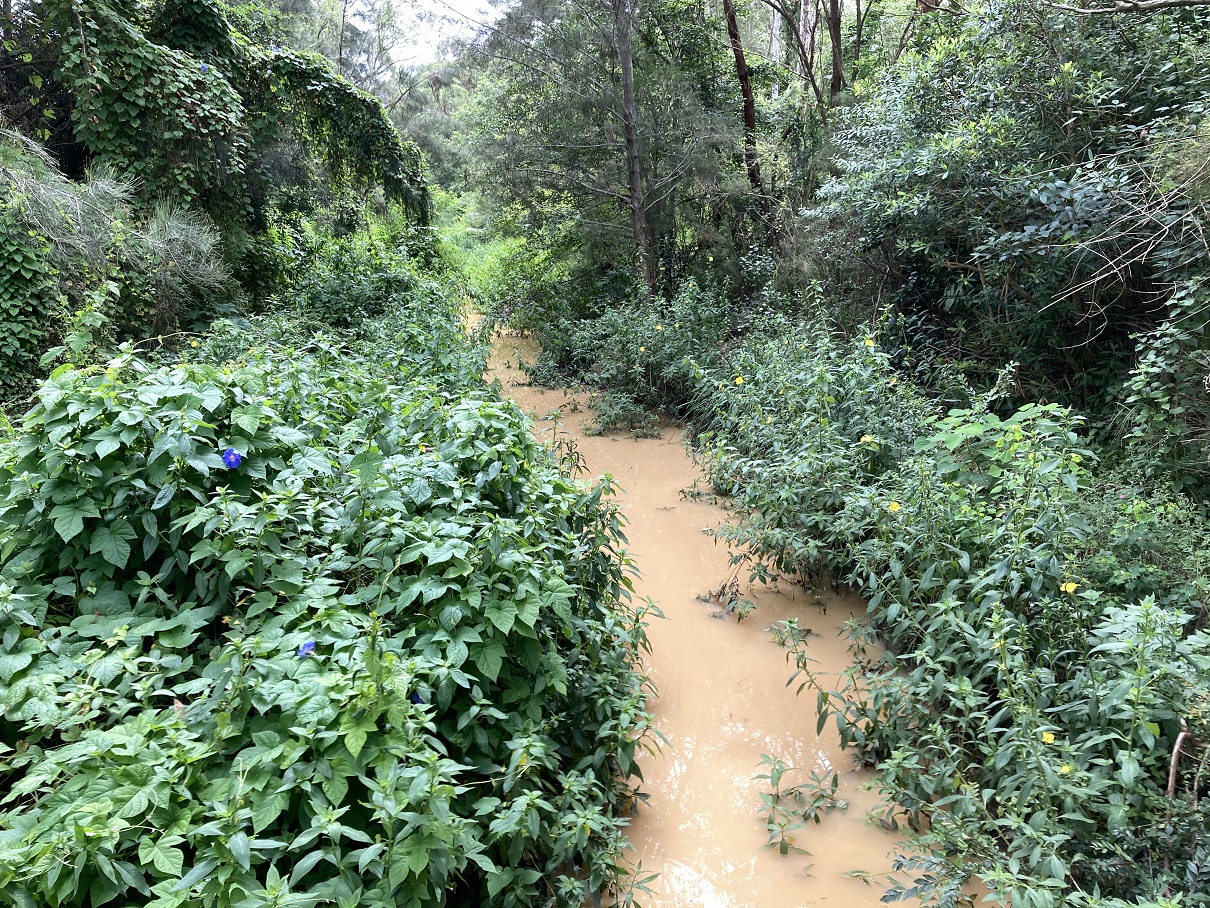Weeds: A Round Table Discussion at Narrabeen on friday July 21 - all welcome!
Over the past few years residents have sent in images of weed infestations in our area, expressing their discontent with Council's actions on requests to remove the same.
See:
- Bangalley Neglect Disgraceful: Lack Of Care Of Bushland Since Amalgamation An Indication Of How Much Council Is Out Of Step With Residents - February 2021, Issue 483
- $15 Million For Crown Land Upgrades: $198,859 Allocated To Council For Weed Control - Governor Phillip Park Misses Out - February 2022
- Sediment Running Off Into Creeks and Beaches From Work Sites - Public Parks Not Maintained – Bilgola Plateau Park Still Not Fixed: Residents NOT Happy' - February 2023
- Warriewood Wetlands - Creeks Deteriorating: How To Report Construction Site Breaches, Weed Infestations + The Long Campaign To Save The Warriewood Wetlands & Ingleside Escarpment - March 2023
- $378,072 Allocated To Council For Weed Control - Governor Phillip Park Gets A Grant This Time: Full Details Of All 11 Sites - March 2023
- the prevention, elimination, minimisation and management of the biosecurity risk posed or likely to be posed by weeds,
- to develop, implement, co-ordinate and review weed control programs
- to inspect land in connection with its weed control functions
- to keep records about the exercise of the local control authority’s functions under this Act
- to report to the Secretary about the exercise of the local control authority’s functions under this Act
As we headed into the Winter 2023 break a Warriewood resident forwarded the following:
Warriewood wetlands choked with weeds: Residents call for Action
Hi at Pittwater Online,
After your mention of Pond 3 in Shearwater Estate (March 19-25 Issue 576) there has been a lot of interest from locals, walkers, Birders, and concerned residents, etc, so much so that the amount of cardboard signs going on the fence has grown again now, even though the Council removes them they reappear again. People are now taking notice of the out of hand growth of the choking aquatic weed growth in Pond 3.
So thank you for the previous mentions in Pittwater Online, maybe you can use this Pic taken today for a follow up story. IE before the Council take them down again.
Personally I think the long term for the whole Wetlands does not look good if Council can not make an effort to stop the spread here before it gets into the whole Wetlands system,
Cheers to you all at PONews, Neil F, June 25, 2023
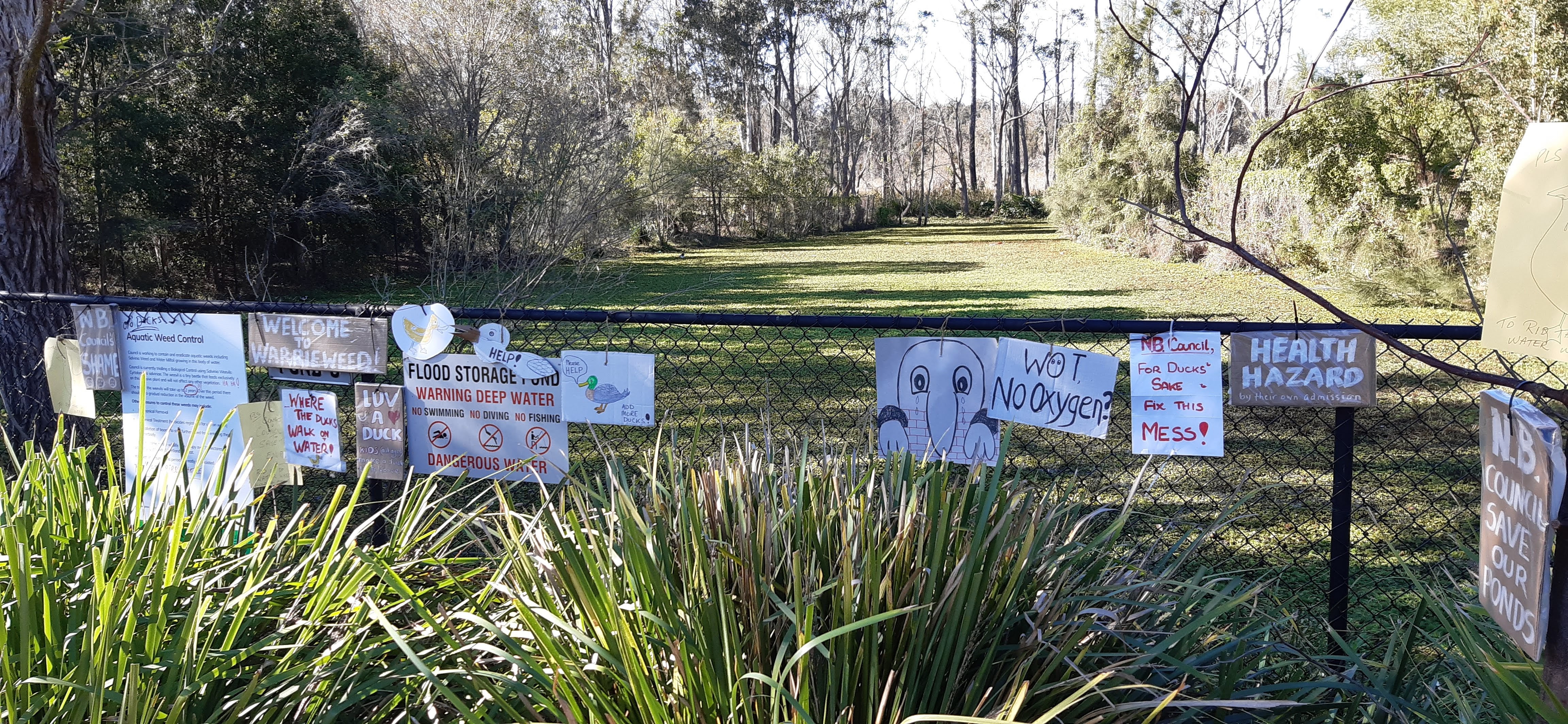
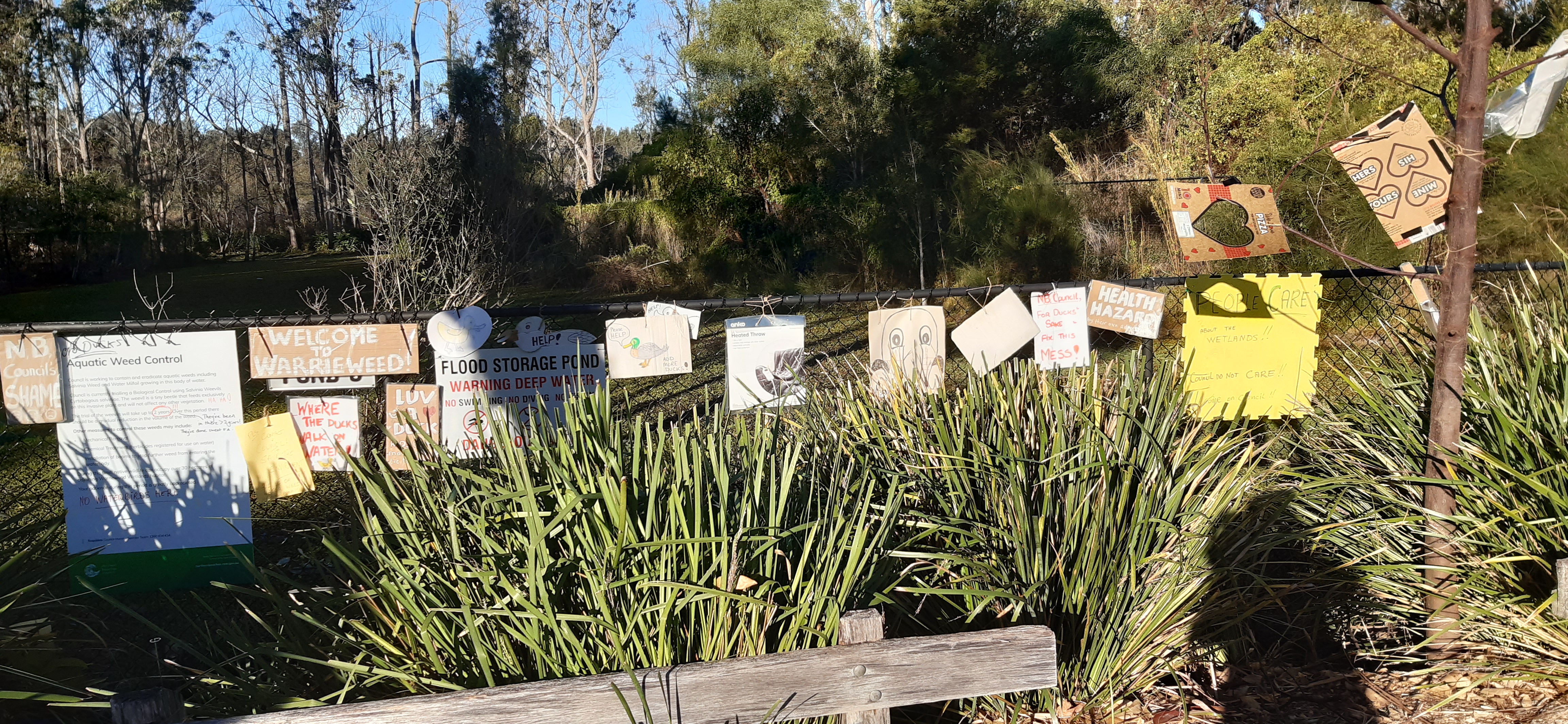
Warriewood Weeds covering pond update:
Update, Friday July 14 2023:
Dear Editor
After your story/Facebook post of the invasion of the water weeds in pond 3 in Shearwater Estate and surrounds of the wetlands, plus the Photo on the fence, it has certainly caused a lot of people to become aware of this problem. Many more signs appeared, put there by Residents, Locals, dog walkers, Birders etc so much so that there about 30 plus signs of the non-action for the Council to see.
Then on Monday 3rd July it all happened; A Council contractor got in the pond 3 in an amphibious machine and started the clean out, also on Tuesday 4th. It is now almost back to normal and looking great, so sometimes they will get on with it after a big push by caring people and a story by local press. (Pittwater Online News). A big thankyou to you all at PON.
Neil F. After Photos: Neil F.
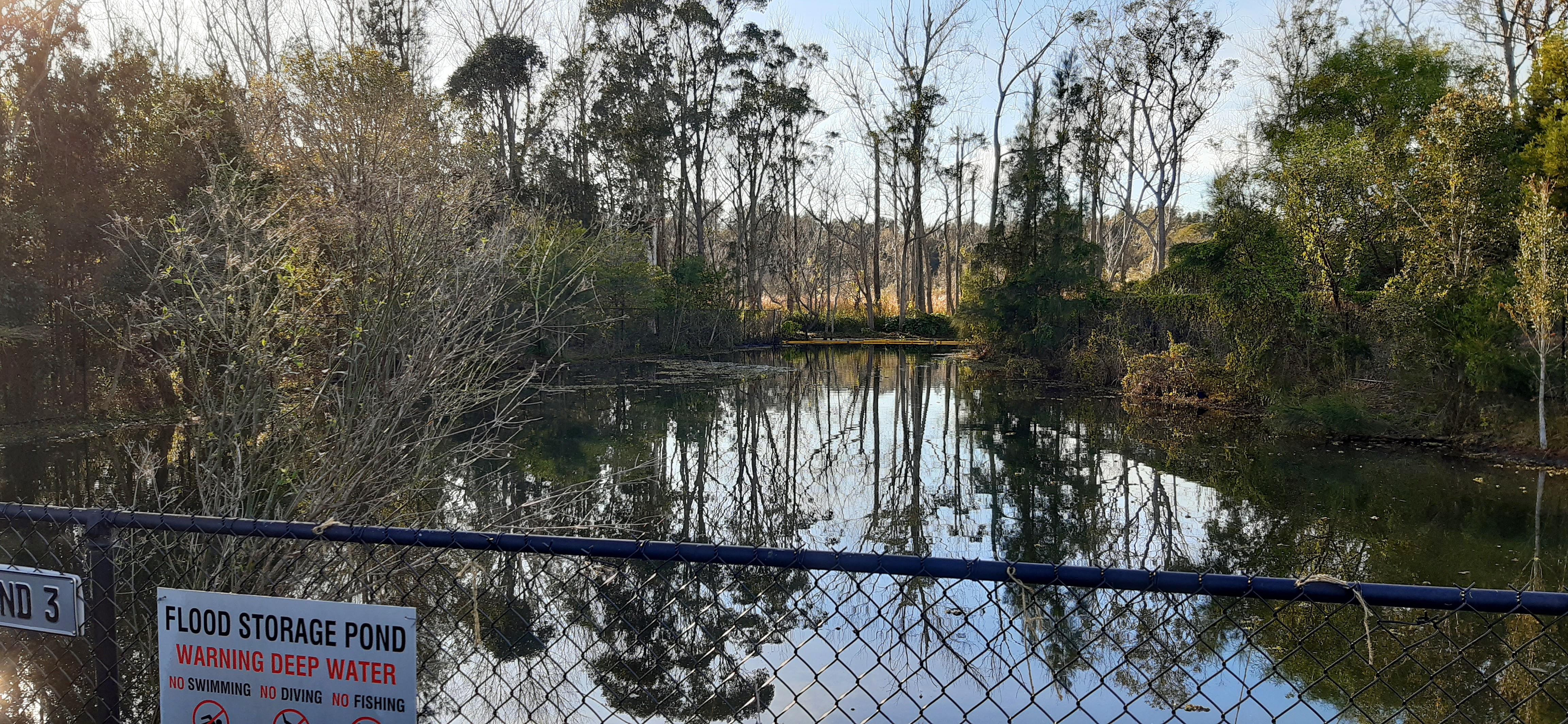
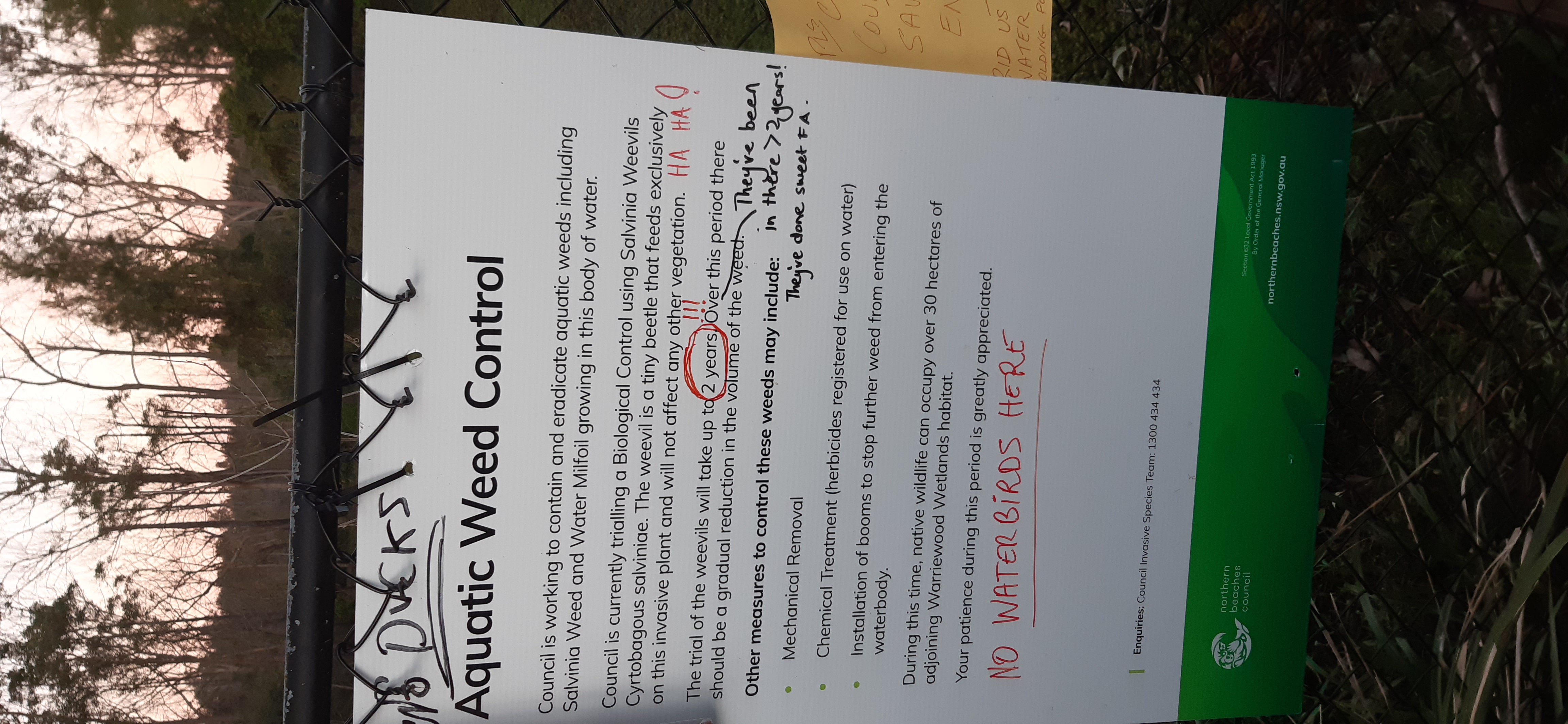
Further to Weeds in Warriewood Wetlands: Photos of The Truxor Aquatic Weed Harvester, the owner/operator comes from the Windsor area, that removed the weeds - images supplied
''All this machinery is available if they (council) would take advice on what is out there. Is this a money thing - are we back under a cosmeytically renamed Warringah Council that rips money out of Pittwater to spend in Warringah and allows weeds to flourish, cracked pavements to go unattended, and encourages overdevelopment?
The Wetlands need attention, this aquatic weeds thing is a v. bad -and all originally imported from overseas, Salvinia Molesta and this Parrot Feather, as they call it, are a huge problem.'' - Warriewood/North Narrabeen Resident Sunday July 16, 2023
Part of the problem is that although the Council can apply for grants to remove large patches of weeds on Crown Land, and issues the work to Contractors once grants have been won, there is a cap on how much is allocated annually. Additionally, many places are not listed as Crown Land and therefore there is no grant to assist with weed management.
Council relies on what can be allocated from its own annual budget and on the hundreds of bushcare volunteers who work to maintain these areas, the bulk of whom have been doing so for years and are now seniors in many instances and unable to do as much as they may have when younger.
Community residents have expressed the notion that maintenance of these areas was not properly factored into the costs of amalgamation. Residents have also spotted other residents dumping their garden refuse in our bush reserves or those alongside the roads, adding to the problem, and have opined that simply putting up a sign does not stop this from occurring.
At the May 2023 Council Meeting PNHA founder Marita Macrae and FoNLC committee member and professional Ecologist Jayden Walsh addressed Councillors on the subject of weeds in our area.
They were speaking in support of a Motion tabled by Pittwater Councillor Miranda Korzy.
Ms Korzy's Motion sought to make information about those weeds that are escaping from private gardens into bush reserves, along with weed information reach-outs and encouraging more, younger, people to get involved in bushcare, as a means of turning back the tide of weeds engulfing so many areas since the forced amalgamation of the three Manly, Warringah and Pittwater councils.
Transcriptions of their words Speaking in support of May 2023 Council Motion submitted by Cr. Miranda Korzy 15.1: Weed Control and Ecological Restoration
Jayden Walsh:
Good Evening Madam Mayor, Councillors and Council staff
I acknowledge that the land that we’re meeting on today of the Gaimaragal Peoples and pay my respects to Elders past, present and emerging, who cared for and care for this biodiversity hotspot we call home.
I’m Jayden Walsh, a professional Ecologist, bush regenerator and lifelong northern beaches resident. I’m extremely passionate about protection and restoration of our unique endemic ecology.
I believe that this Motion is a good step in the right direction towards addressing crucial and time sensitive issues regarding the living health of our area. It is long established but often ignored that if you look after the geology, flora and fauna, Country, then it looks after you. The more you see and know the interconnectedness becomes apparent. Rock and soil type directly influence the vegetation communities, dictating the distribution of fauna, including the over 110 threatened species that call our LGA home.
With this knowledge it becomes obvious that to carry out the obligations of the EPBC, Biodiversity Conservation Act and Biosecurity Act to protect these 110 threatened fauna species the remaining habitat must be in optimal quality.
Take for example Bilgola bends Reserve, a threatened ecological community of littoral rainforest and Pittwater Wagstaffe Spotted Gum Forest that is habitat, amongst many things, for the vulnerable squirrel glider, that is a unique endangered population on the Barrenjoey peninsula.
We should be proud that this species occurs here, the only LGA in Sydney in which it does, and rather than sending the species into local extinction through logging on private property, deterioration of council reserves, low public rhetoric, we should celebrate, idolise and protect this species.
If this species population was recovering, rather than disappearing, it would mean we had made progress in improving the condition of our immediate area and therefore the physical and mental health of your constituents, including reduced risk of Type 2 diabetes, heart disease, depression, and a wide range of other mental health outcomes.
Another issue that must be remedied soon is the lack of long-term strategic planning specific to each of our bushland reserves. I frequently refer to the Plans of Management written for many Pittwater Reserves. However, many are older than I am.
If Northern Beaches Council is serious about long-term protection and restoration of our ecology then a more productive, innovative and comprehensive tack is urgently needed. Ultimately, the Councillor Korzy’s ecology Motion is imperative to the health and wellbeing of all native organisms within our LGA, who we so greatly rely upon.
It is clear that Councillors whop do not want to vote for this Motion do not truly care about their constituents or the welfare of life on earth.
Marita Macrae:
Good evening everyone. My name is Marita Macrae. I’m speaking in support of Cr. Korzy’s Motion 15.1 on behalf of Pittwater Natural Heritage Association and I’d like to make these points.
We believe the weed problem is a serious threat to our biodiversity, particularly in the Pittwater area with which we’re familiar, and that Council, while often claiming excellence in environmental management, overlooks this growing problem. The longer it’s ignored the worse will be the result of neglect.
The Pittwater area looks green and lush but quite a lot of the greenery is large woody weeds such as African olive, tuckeroo, broad leafed privet, small leafed privet and so on. The native cissus vines become weeds when they climb up into canopy trees.
Regarding information about weeds on the Council’s website. On the homepage there is a box for quick links; we are asked ‘what do you want to do today?’.
But if you type ‘weeds’ into that box the message replies ‘there is no link for that yet’.
Well why not?, I ask.
Via the slow link to the weeds page we find links to follow that take you to headings, one of which is ‘Weed Management’, apparently with an ‘image of lantana’, but that image is blank.
Further down the page, under the heading ‘Weed Profiles’ are links to 7 weeds but 3 of their images are absent. The webpage needs more upfront information and photos of local weeds and less text about ‘biosecurity risks’ etc., that confuse the issue for people just wanting information such as ‘is this plant a weed or a native?’, ‘how can I get rid of it if I have to?’
The Council’s Local Priority Weed Management Plan lists 56 weeds but has no photos, and it contains, for example, such as this – about Arum Lily;
‘Land managers prevent spread from their land where feasible.’ – ‘Identify priority assets for targeted management.’ – ‘On public land weed will be strategically controlled and reduced according to available resources.’ Etc. etc. – and that’s for every of those 56 species.
This Plan document may satisfy regulations of the Biosecurity Act, but it’s not very meaningful for the general public. The implicit vagueness makes you wonder if anything will ever actually be done.
How can people find out about weeds and bushcare – providing information on the website assumes people wish to go looking for it. On weed pages there are useful links, if you already have an idea of what you want to know. But most people probably don’t know what they don’t know.
In contrast, Council needs to do more outreach to increase awareness of weeds and knowledge of bushcare. Weed workshops are a great idea and I’m sure many experienced bushcare volunteers would be ready to assist. We’re convinced there is no substitute for hands on weed education.
Finally Councillors, please support this Motion and help our community to care for our natural environment.
Thank you.
Cr. Korzy, in her May 2023 'From the Chamber' update on the May 2023 Meeting, stated:
Boost to Weed Control and Support for Bushcare Volunteers on its way
For those struggling to work out if a plant in their garden is a weed or not, council passed my motion on Tuesday for better public information to identify weeds and a report into how to prevent their sale and engage more bushcarers.
Volunteer bushcarers often tell me about weeds proliferating in parks, reserves and dunes across the LGA. In April, one wrote to councillors, complaining about the neglect of a previously well maintained bushcare site at Mona Vale Dunes. Volunteers had weeded and regenerated the site, but since then, it had returned to its previous state of infestation, leaving them wondering at the futility of their work.
The motion was largely written by Northern Beaches Greens convenor Evan Turner, in consultation with Pittwater Natural Heritage Association (PNHA) members and Conservation and Land Management experts. PNHA secretary and veteran bush regenerator Marita Macrae addressed the meeting about the extent of the weed problem, and local ecologist Jayden Walsh discussed the broader implications for the environment.
Originally, the motion noted the massive ecological and economic cost associated with the proliferation of weed species in the Northern Beaches Local Government Area. To combat this it proposed building community awareness of weed species to curb their proliferation in residential gardens; and encouraging community involvement in bushcare. (This earlier section was dropped to incorporate an amendment.)
Developing a comprehensive and accessible new section of the council website, detailing all local priority weeds, was the first measure proposed. Secondly, a public education campaign about weed control, for example on social media, with pamphlets and fridge magnets to help build community awareness.
The motion also called for a report within four months into opportunities for engaging more bushcare volunteers, especially young people, and particularly high school students, to increase the volunteer base and enable transfer of important local knowledge from older and more experienced volunteers.
Recommendations for ways Council could discourage the sale of weeds species by local plant nurseries and community markets, and consideration of the weed potential of native plant species and ways to control their spread, were also key points.
Ms Grattan moved an amendment that I was happy to accept into the motion, that basically rearranged some points and added a clause: that staff re-assess the timing and prioritisations of service reviews and the possible inclusion of “weed control and management” amongst them.
Mr Glanville and Mr De Luca both mentioned that council has a legal duty to manage biosecurity risks such as weeds.
“This is not optional - we need to be better at exploring how we can manage weeds,” Ms Glanville said.
“The entire area is plagued by weeds,” Mr De Luca said.
“Residents point out the danger of vermin and foxes running around in them.
“I do think it’s time we prioritise this issue.”
Ms Heins said bushcarers did amazing work.
“After two years of lockdowns and (wet) weather it must have been absolutely heartbreaking, then add in the bike tracks,” she said.
“We must do as much as we can… I hope we get more bushcare volunteers out of this as well.”
I thanked the 350-plus volunteer bushcarers who work at over 50 different sites throughout the Northern Beaches, conserving and regenerating publicly owned bushland.
The environment is the number one priority of all Northern Beaches residents and our bushcarers help ensure the survival of our precious vegetation and habitat, I said.
The proliferation of weeds on the Northern Beaches is also a significant cost to the council. In the current financial year, we budgeted $5 million for bush regeneration - on top of more than 6,000 volunteer hours.
“It would benefit us and the environment if we better supported our volunteers, many in their 70s with professional expertise, and engage new recruits who could learn from them,” I told the meeting.
“Young people have expressed a wish, via the Youth Voice Action Plan, to join community activities with older residents. Some local schools have run bushcare programs for school sport and many support Duke of Ed programs with a volunteering element. These could be great avenues for mentoring and building the ranks of volunteers.
“The proliferation of weeds in private gardens throughout the Northern Beaches is also a significant issue that often results in spread to council-managed areas. Many of these weeds are sold to and cultivated by residents, for example, Prickly Pear.
“In the past, Prickly Pear escaped from gardens, colonising parts of Bangalley Headland at Avalon, and the cliffs between Dee Why and North Curl Curl. Yet with the current fashion for architectural plants, we see Prickly Pear returning to private gardens and outside local businesses.”
“Various plant species, native to NSW but not the Northern Beaches, also have invasive potential and are creating major issues in local ecosystems whilst requiring council funding to control.
“Tuckeroos, for example, were planted as street trees in Pittwater but are now spread by birds and multiplying in local reserves. These species should not be planted by council on public land and we should discourage the sale and cultivation of these as for other weed species.”
The motion passed unanimously.
So what else can be done apart from encouraging the Council to 'get on with it' and supporting their work by pulling out the weeds in your own garden or reporting problems so they can fix them?
A glance over what has been successful in the recent past, such as the PNHA initiative to trail a Trad Biocontrol Release In Pittwater in 2020, which is proving effective, may help.
Joining your local bushcare group and just doing a few hours each month will help too.
How can we get those inheriting the place involved now that those who have carried the load are getting too creaky of joint and limb to keep on?
In 2013 Pittwater Council and the Pittwater Natural Heritage Association successfully ran an Asparagus Fern weeds out day at Palm Beach dunes years ago which attracted 110 younger bushcarers as a ticket to a concert was the reward - with lots of support from Optus see; Give-Get Given Barrenjoey Asparagus Fern Out Day
Would the next generation to carry forward environment keeping swap a few hours of bushcare each month for a ticket to an all-ages concert by The Rions or the Lime Cordiales? You bet they would!
Pathways in our schools are already allowing youngsters to connect with bush restoration and the benefits from it, along with the Duke of Edinburgh award allowing for bushcare volunteering as part of what you can do - why not extend that into an Ecology pre-uni 'try it out' pathway for work experience?
Our kids LOVE the environment; they're always out and about in it - giving them an opportunity to via The HSC + School Based Apprenticeship and Traineeship (SBAT) already allows for Horticulture options - why not campaign for that be expanded into Ecology courses with waived fees as there is for other Apprenticeships? The future needs them - in fact, the present needs them to follow their passions right now.
There is also those who have long worked on this problem coming up with ideas.
On Friday July 21st a new move to find innovative ways to address the weeds in our area, with all welcome, will take place as a Weeds Roundtable Discussion at the Narrabeen Tramshed.
Conny Harris has organised this Round Table to discuss the problems with weeds in our area, which are a serious threat to our biodiversity.
You might enjoy this event if you battle with weeds in your garden, work in a Bushcare group, or just tire of seeing weeds along roadsides everywhere.
The Agenda is below, with some reading for you before the event. Another attachment (also below) explains just what is a priority weed.
This Issue an old page in the JBH DIY section includes Pittwater Council's list of weeds and photos to support us all in ripping out what may spread into bush reserves, runs again. Now is a great time to get on top of weeds before Spring arrives and they bloom then seed further.
Weeds: A Round Table Discussion; Narrabeen - July 21
Conny Harris has organised this Round Table to discuss the problems with weeds in our area, which are a serious threat to our biodiversity.
We will have weed specimens to help the discussions, and PNHA Cards will be for sale.
All Welcome
Weeds Round Table on July 21, PLEASE RSVP to Conny Harris if you would like to attend. Her email: conny.harris@gmail.com
Conny is providing Pumpkin soup and sourdough bread for supper.
Weeds: A Round Table Discussion
The Tramshed, Pittwater Rd Narrabeen, Friday July 21, 6-8pm
Conny Harris has organised this event because many of us are concerned about weeds increasing in the Northern Beaches area.
What can be done?
Agenda
1. acknowledgement of country
2. introduction of attendees
3. focus - why this forum?
4. presentation by Sonja Elwood, Coordinator, Invasive Species Northern Beaches Council (as per questions sent earlier)
5. discussion within the group about our experience with new or particular strongly emerging weeds.
6. conclusions/ recommendations
>>>>>>>>>>>>>>>>>>>>>>>>>>>>>>>>>>>>>>>>>>>>>>>>>>>>>>>>>>>>>>>>>>>>>>>>>
In advance of the Roundtable discussion, Council staff have provided answers to the following questions asked by Conny in a recent email.
1) Priority weeds for Council and their management:
Council's priority weeds are listed in Council's Local Priority Weed Management Plan. Weeds are managed in accordance with the requirements of the NSW Biosecurity Act 2015.
2) Where are these priority weeds predominantly?
Priority weeds may be found in a variety of locations including private lands and gardens, bushland reserves, creek lines, major roadways and/or degraded building or development sites.
3) How does the Council care for areas with very high biodiversity?
Council objectives for managing land with very high biodiversity are identified in Council’s Bushland and Biodiversity Policy. Council has limited powers over conservation and management (of weeds) of land that is private land or land that is not under our care and control. Funding for management of weeds is limited to land under Council’s care and control. Management of weeds in Council’s reserves is guided by Council policy which states “The restoration and enhancement of public bushland will be prioritised based on both conservation significance and the level of public interest”. Areas of conservations significance within individual reserves are determined by the relevant bushland management officer and based on Council mapping and local expert knowledge. In many instances, management is also guided by relevant Plans of Management.
4) What coordination is in place between roadside maintenance crews and your department?
Council Teams collaborate when carrying out works in sensitive areas such as Bushland and Endangered Ecological Communities (EEC's). The majority of the Parks road side maintenance involves cutting back vegetation from around 1 - 2m in from the road edge to maintain sight lines and safe road access for pedestrians and other road users. Council uses experienced contractors who have been carrying out road side maintenance in most of the bushland areas of Terry Hills, McCarrs Creek, Elanora Heights, Belrose and Ingleside for many years and are well aware of areas of EEC or threatened ecological communities.
5) What coordination is in place with RFS for planned burns?
Council has identified 42 burns for the 23/24 Annual Hazard Reduction Burn Program throughout various reserves and parks which not only contribute towards reducing bush fire risk, but also work towards maintaining diversity and ecological goals.
Council works closely with the relevant fire agency (NSW Rural Fire Service or Fire & Rescue NSW) to plan, prepare and implement Council proposed burns as weather and operational opportunities allow prioritised on risk.
Other land managers such as the NSW National Parks & Wildlife Service or the BFMC sometimes propose burns that may involve areas of Council land. Council works closely with these agencies through the BFMC to review any such proposals and provide appropriate permissions as required.
The BFMC is currently working towards renewing the two existing Bush Fire Risk Management Plans. The committee has recently publicly exhibited a new draft Bush Fire Risk Management Plan. The plan is on exhibition until 17th July after which time the BFMC will be working to reviewing any community and agencies comments prior to finalising and adopting the new plan.
6) What responsibility for weed control do the Parks and recreation department, and the department in charge of road maintenance have?
Council Teams collaborate when carrying out all proposed works, in particular our teams work extensively with Pamela Bateman our Weed Management Officer to ensure that we address weed outbreaks.
Also: Northern Beaches Draft Bush Fire Risk Management Plan (open for submissions until 17 July 2023)
 | DPI Primefact What is and what is not a priority weed Biosecurity Act JUN2023 (1).pdf Size : 532.84 Kb Type : pdf |
